bio exam #2
1/68
There's no tags or description
Looks like no tags are added yet.
Name | Mastery | Learn | Test | Matching | Spaced |
|---|
No study sessions yet.
69 Terms
genetic drift
any change in allele frequency in a pop. that occurs due to random change (not a mutation)
what are the 2 ways genetic drift can happen by?
random removal of organisms from breeding pop.
founder effect: movement of a small number of individuals from a given pop. to a new location where they start a new pop.
what is bottle neck effect?
third cause of genetic drift, where a major disaster occurs and randomly kills almost all individuals in a pop.
side effects of bottle neck effect
small number of survivors, reduced genetic and allele diversity
microevolution
overtime small changes accumulate, can lead to formation of new species, which is macroevolution
morphospecies approach
using physical appearance to define a species
issues with morphospecies approach
sexual dimorphism: females and males look different from one another in a pop.
cryptic species: 2 or more species that are identical
polymorphic species: members of that same species that look different and can breed sucessfully
biological species concept
ernst mayer, defined species as groups of actually or potentially interbreeding natural pops. that are reproductively isolated from all groups
reproductive isolation
isolation of a pop. caused by something that blocks reproduction
issues of reproductive isolation
cannot be used by asexual organisms
cannot be used by self-fertilizers
cannot be used by organisms only known from extinct fossils
phylogenic species concept
based on the evolutionary history of individual populations, starts with a common ancestor that other pops. have descended from
speciation
production of new species starts with genetic isolation, then pops. begin to diverge genetically through natural selection, mutation, lack of gene flow, genetic drift
pre zygotic isolation
before the zygote forms, mating cannot occur
post zygotic isolation
after the zygote has formed
mechanical isolation (pre)
physically impossible for breeding to occur, male and female reproductive parts do not match up
lock and key issues (pre)
body size must match, and some organisms have diverse penile shapes
habitat isolation (pre)
organisms live in same location but ecological differences prevent mating the
behavioral isolation (pre)
organisms that live in the same location, but behavioral issues prevent breeding (songs, calls, ritual ships)
temporal isolation (pre)
breeding periods of 2 species occur at different times, zero potential for breeding
isolation by prevention of gamete fusion (pre)
something prevents sperm from fertilizing the egg
sperm-egg incompatibility (pre)
something prevents sperm from penetrating egg, usually from incompatibility of sperm heads
hybrid inavalibility (post)
accumulation of genetic issues or differences from mis-matched sperm eggs causes offspring to die soon after birth
hybrid infertility (post)
offspring produced of closely related species survived to adulthood, but they are sterile or infertile
partial isolation
individuals that breed with members of other pops. frequently have low to no reproduction (fitness)
allopatric speciaition (general modes of speciation)
when pops. are seperated geographically, breeding and gene flow are impossible separated
through dispersal (general modes of speciation)
pop. splits, joins with new pop. in a new location (remain separated, isolation, to genetic divergence, to speciation)
vicariance
a change in habitat changes the pop. or splits into new pop.
causes of vicariance
volcanoes, continental drift, river flow changing, roads installed
sympatric speciation
pop. lives in the same area but there is no gene flow
sympatric speciation cause
mutation, chromosomal event
chromosomal event
change or difference in chromosome number btwn parents and offspring
autopolyploidy
change in chromosome number in self fertilization in hemaphrodites (male and female reproductive parts), leads to errors in gamete production
cause of autopolyploidy
external events, something alters the breeding habits or habitats of individuals
allopolyploidy
individuals from two similar species that interbreed
tetraploid vs diploid
offspring with 4n vs 2n (results from autopolyploidy)
effects of allopolyploidy
prevents breeding, to no gene flow, to isolation, to divergence, to speciation
strong host specificy
always breed on same species of plant (courtship behavior)the
what happens if an external event causes strong host specificy to fail?
habitat isolation to no gene flow, to genetic divergence
adaptive radiation
single species that rapidly evolves into several descendent species
adaptive radiation by ecological opportunity
occurs when intense competition for resources arise
species involved must have existing variation
different species have different growth forms
today all species share a common ancestor, rapid speciation rates, and diversified ecologically and physiologically
what does adaptive radiation require?
significant trait variation and selective pressure
adaptive radiation when new traits evolve
can be caused by physiological, morphological, or behavioral changes
driven by mutation
new trait may allow organisms to use new food sources or new habitats
altered reproduction
new models of reproduction and pollution, occurs in flowers
causes of altered reproduction in flowers
altered distribution of plants
colonization of new habitats with successful reproduction
increasing likelihood of new pollination (new shape, color, odor)
extinction
can alter speciation, rapid large reductions in number of species alive
human driven extinction
lose of species caused by humans, for example deforestation
phylogenetics and history of life
associated with how we describe species diversity and determining evolutionary relationships among organisms
what issues can arise with naming organisms?
everyone names things differently
can be named by physical characteristics
can be named to resemble different organisms
can be named by the habitat they are found in
can be named by personal experience or cultural refrences
binomial nomeclature
species named by their genus + species
systema naturae
written by carolus linnaeus, defined naming species
hierarchy nomenclature
kingdom, phylum, class, order, family, genus, species
carl woese
added domain above kingdom
phylogenetics
system used to organize organisms through hierarchies
synapomorphies
shared characteristics between organisms
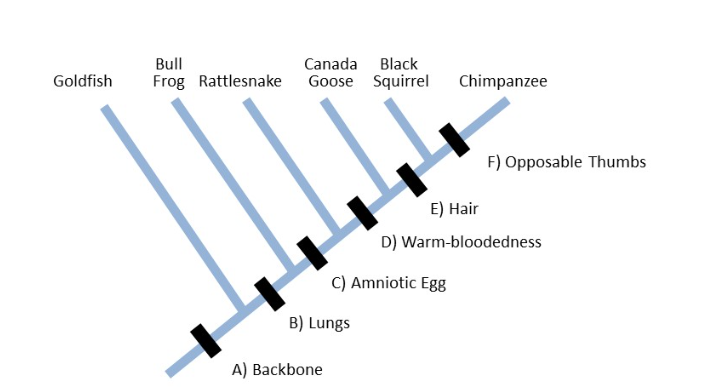
Based upon the shared characteristics that this phylogenetic tree is built upon, are Canada Geese more closely related to Goldfish or Chimpanzees?
chimpanzees
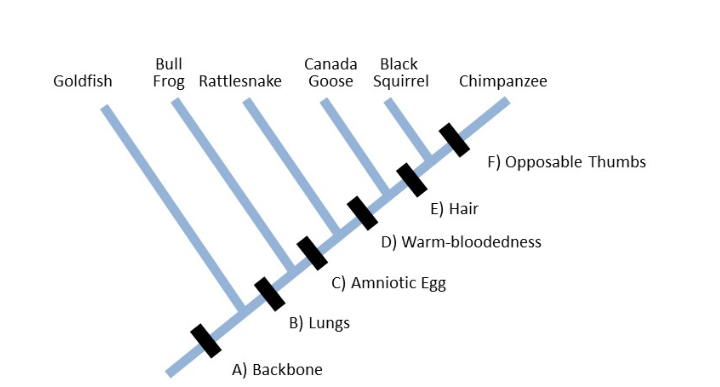
Using the letters on the appropriate bars, what is the most complete listing of traits that Rattlesnakes and Chimpanzees share?
A, B, C
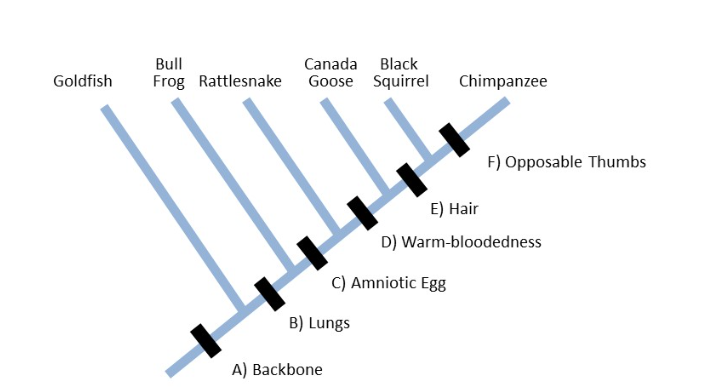
While exploring the wilds of Siberia, I discovered a new bird called an “OBOE HERON”. The oboe heron has traits found at bars A, B, C, and D. Where would you place this animal on the phylogenetic tree above?
with the canada goose
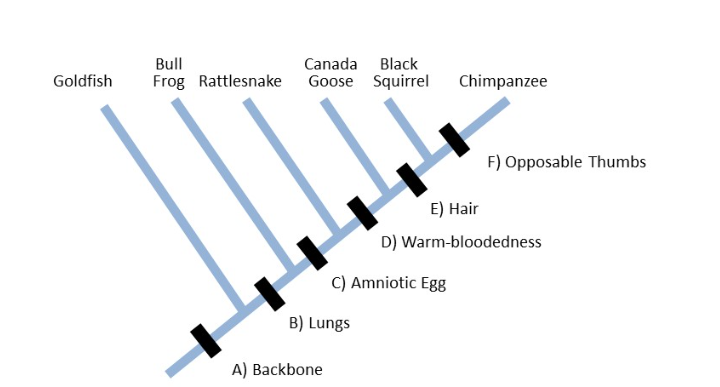
Choose all organisms from this phylogenetic tree that share the "warm-bloodedness" trait (bar D)
canada goose, black squirrel, and chimpanzees
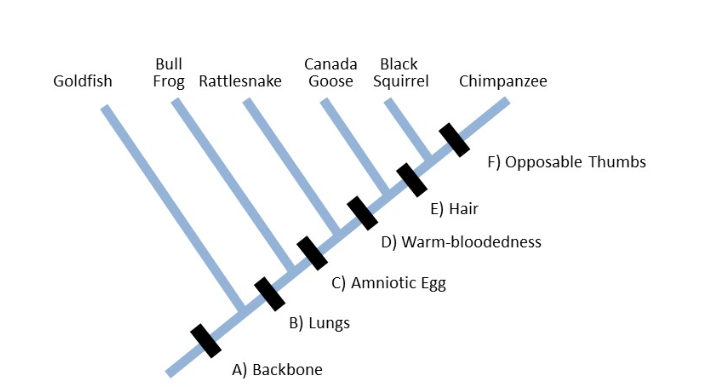
Based upon this phylogenetic tree, choose all traits below that are shared by mammals (black squirrels and chimpanzees on this tree).
backbone, warm blooded, lungs, hair, amniotic eggs
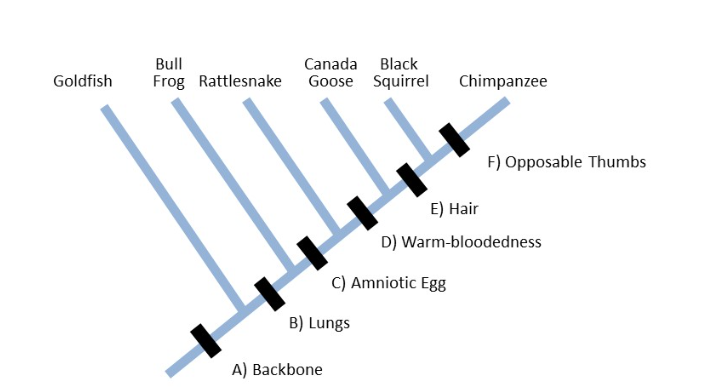
The backbone is a trait shared by all organisms on this phylogenetic tree
true
prokaryotes
most abundant life forms, include bacteria and archaea, date back to 3.5 million years old, earliest are cyannobacteria
archaea
very simple, no pathogens, have symbiosis
primary extemorphies
associated with extreme abiotic conditions, classified based upon where we find them and the roles that they play
thermophiles
associated with extremely high temps, growth temp between 140-175 F
acidophiles
associated with extremely low pH levels, always below 2, found in bogs, forests, and foods like yogurt and sour cream
halophiles
found in extremely high salt levels , grow at 35-45% salt environments, found at saline lakes, and foods like kimchi
methanogens
noted methane producers, found in areas like wetlands and swaps, used as energy sources
bacteria
prokaryotes that lack membranes, also have huge diversity
gram-staming
divides bacteria by physiology and cell structure, shows positive and negative bacteria